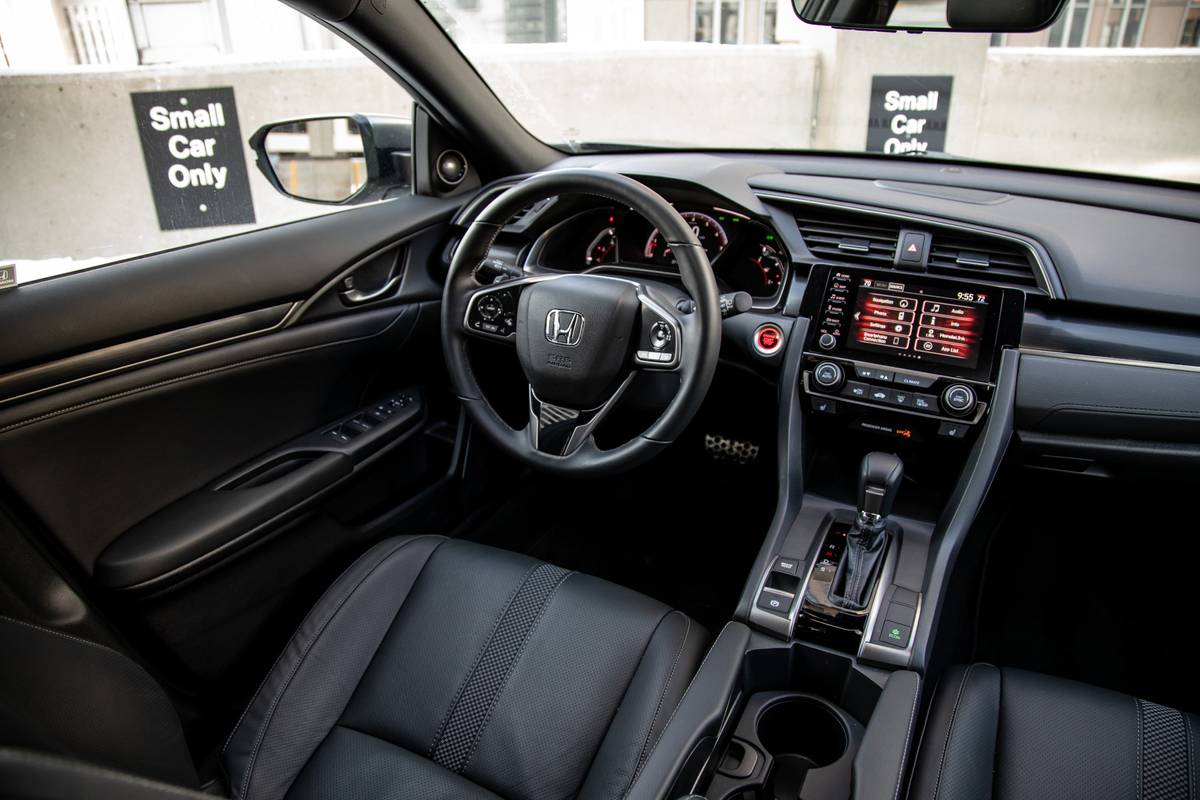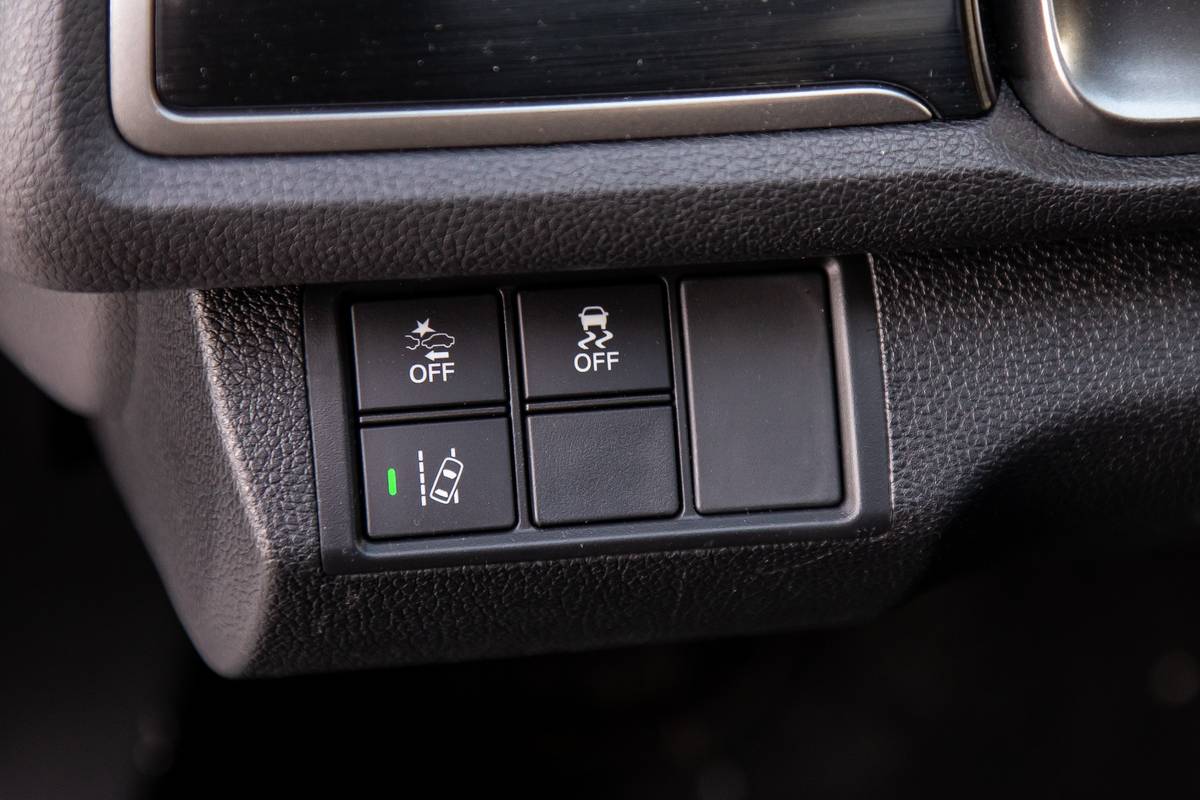2020 Honda Civic Hatchback Review: Still King of Compacts




























































The verdict: There are a bunch of reasons why the Honda Civic routinely tops compact-car sales charts — comfort and value among them — and the Civic hatchback adds utility to the list.
Versus the competition: It out-handles many in its class and adds better fuel economy and more cargo room.
Honda’s Civic small car is available in sedan, coupe and hatchback body styles; this review covers the hatchback version, which entered the lineup for 2017. For 2020, it gets some more aggressive front and rear styling, as well as additional convenience features.
The Civic competes against other hatchbacks in the compact class, such as the Mazda3, Subaru Impreza and Toyota Corolla. See them compared.














Pep and Poise
The hatchback’s styling is slightly sportier than the sedan’s, and its driving manners back that up. While the hatchback isn’t exactly exciting, it doesn’t disappoint. It’s a comfortable, composed, decently peppy cruiser. It stands out for its combination of agility and composure, with a nimbleness around corners and a ride that’s firm but never uncomfortable.
Most versions of the hatchback use a 174-horsepower, turbocharged 1.5-liter four-cylinder engine paired with a continuously variable automatic transmission. In the topline Sport Touring trim, which I tested, buyers get an additional 6 hp and can choose either the CVT or a six-speed manual transmission. The hatchback also comes in an ultra-performance Type R trim that seats four and is powered by a 306-hp, turbocharged 2.0-liter four-cylinder paired with a six-speed manual transmission.
- ${price_badge()}
- ${ami_badge()}
- ${battery_badge()}${ev_report_link()}
- ${hot_car_badge()}
- ${award_badge()}
- ${cpo_badge()}
${price_badge_description}
${ami_badge_description}
The EV Battery Rating is based on this vehicle's current expected range relative to the vehicles expected range when new. ${battery_badge_text}
Certified cars are manufacturer warrantied and typically go through a rigorous multi-point inspection.
This car is likely to sell soon based on the price, features, and condition.
${award_blurb}
${award_two_blurb}
Shop the 2020 Honda Civic near you


I tested a CVT-equipped Civic hatchback that set itself apart from the crowd. The transmission lacked the unnatural, dull feel of many CVTs on the market, steadily delivering power in smooth, predictable blocks. The car felt slow only when Eco mode was enabled, which dulled acceleration response to benefit fuel economy. (After testing it briefly, I avoided Eco mode.)
The hatchback is no slouch when it comes to fuel economy. It’s EPA-estimated rating of 31/40/34 mpg city/highway/combined is around 2 mpg less than the Civic sedan with the same engine. The Corolla hatchback is rated similarly, at 32/41/35 mpg, and other competitors have much lower numbers: A two-wheel-drive Mazda3 with an automatic transmission is rated 26/35/30 mpg, while the all-wheel-drive-only Subaru Impreza is rated 28/36/31 mpg with an automatic transmission.






















Cabin Highs and Lows
Much of the cabin’s design and materials are forgettable, but its multimedia system stands out — for better and for worse.
Honda gave the Civic’s Display Audio system a volume knob (but still no tuning knob!) for 2019, and it was a welcome addition to the touchscreen — but it’s time for more upgrades.
The small screen is still responsive to the touch, its menu structure is straightforward, and its Apple CarPlay and Android Auto smartphone connectivity are easy to use, but the graphics look dated and the climate controls need a revamp. Working the system requires using both touchscreen-based controls and physical buttons under the screen; it would be easier (and look more streamlined) if they were in one place. A tuning knob is obviously also still on my wish list.
In back, both headroom and legroom are competitive; my 5-foot, 6-inch self fit comfortably. The Civic hatch matches many other compact hatchbacks in rear legroom and offers much more than the Toyota Corolla. The backseat is also plenty roomy for child-safety seats; two fit comfortably, and it was easy to access the Civic’s lower Latch anchors and top tether anchors. Our test model had a fixed head restraint, however, which caused problems when installing our forward-facing convertible seat. Read the full Car Seat Check.
In the wayback, cargo room is plentiful. Hatchback Sport models offer 22.6 cubic feet of space — more than the Mazda3, Subaru Impreza and Toyota Corolla hatchbacks. (Though the Civic sedan’s trunk capacity is listed as 15.1 cubic feet, the two specifications can’t be reliably compared because of differences in how they’re measured.) With the seat folded, total cargo room increases to 46.2 cubic feet, slightly less than the Mazda3 and Subaru Impreza; Toyota has not released the Corolla hatchback’s maximum cargo dimensions.
The Civic also impresses when it comes to small-items storage, with big door bins and a deep, multi-tiered center console. There’s also a large open storage bin under the shifter.
More From Cars.com:
- Shopping for a 2020 Honda Civic? Research One, Now
- Find a 2020 Honda Civic for Sale Near You
- Cheap Thrills: 6 New Cars With Small Price Tags and Big Fun
- Best Commuter Cars
- How Do Car Seats Fit in a 2020 Honda Civic Hatchback?
Safety and Value
Safety is another win for the Civic hatch. The Honda Sensing system is standard across the lineup, including forward collision warning with automatic emergency braking, lane-centering steering at higher speeds and adaptive cruise control that operates all the way to a stop.
The Civic has a similar level of standard safety features as the Madza3, Toyota Corolla and Subaru Impreza hatchbacks, but it offers a helpful feature on the EX trim level that those competitors don’t: Honda’s useful LaneWatch system, which uses a camera in the passenger-side mirror to help you keep an eye on things on the right side of the car, like cyclists in a bike lane. I find this system very helpful in city driving and wish it were on both sides of the car — and more Honda vehicles (only some offer it).
The 2020 Honda Civic Hatchback starts at $705, less than the Mazda3 but a little more than the Toyota Corolla hatch and a lot more than the Subaru Impreza (which has standard all-wheel drive). The Civic hatchback is also $1,900 more than the sedan. All prices include destination fees.
Month after month, shoppers in the compact class choose the Honda Civic over many rivals, and the 2020 model only makes its case stronger — but how much are you willing to pay for some extra cargo room?
Cars.com’s Editorial department is your source for automotive news and reviews. In line with Cars.com’s long-standing ethics policy, editors and reviewers don’t accept gifts or free trips from automakers. The Editorial department is independent of Cars.com’s advertising, sales and sponsored content departments.

News Editor Jennifer Geiger joined the automotive industry in 2003, much to the delight of her Corvette-obsessed dad. Jennifer is an expert reviewer, certified car-seat technician and mom of three. She wears a lot of hats — many of them while driving a minivan.
Latest news



